Again February seventeenth, preparing a revolutionary revolver for satellite navigation

Today, the emerging industry of unmanned aerial and ground vehicles require reliable high-precision positioning. Apps on mobile devices also require a higher positioning accuracy. These tools must be compact, low power and cheap. Until now, there was a gap between these new demands and characteristics of products and prices. Giants of the navigation industry would not or could not offer products with desired properties.
Now the situation is beginning to change rapidly.
Roughly speaking, precision is the positioning accuracy to centimeters. This problem can be solved in the local area, that is, based on the selected base station, and may, without supports, that is, on a global scale. Each of these tasks can be implemented in real time, or record, i.e. in deferred mode. The main problem to overcome on the way to accuracy, the physical instability of the delay of an electromagnetic wave in ionosphere. To compensate for ionospheric error, which reaches two meters, use either simultaneous reception of the satellite signal on different frequency, or corrections from base stations when applying for the frequency. The main advantage of dual-frequency receiver in the absence of the need of a network base station. Of course it is possible to mix technologies, that is, for example, dual-frequency system using amendments from the base station, where dvukhchastotnyi is used to accelerate the convergence of the navigation solution and to increase its reliability in changing the availability of satellite signals.
The hardware of high-precision receivers, including multi-frequency and multi-system, perfected over decades and her the cost is small. Large kilobaksov, which today are dual frequency receivers from the market leaders, mainly obtained for the used software.
Despite the fact that the main difficulty of high-precision equipment and software lies in the plane, it all started with a hardware simplification. The Minsk-based company Ntlab has developed and launched serial production of the chip NT1065 — multi-constellation multi-frequency radio receiver. Roughly speaking, this thing turns signals from one or more antennas, up to four digital counts. It covers all the existing and planned frequency bands of satellite navigation systems. These systems and frequencies are listed in detail here.
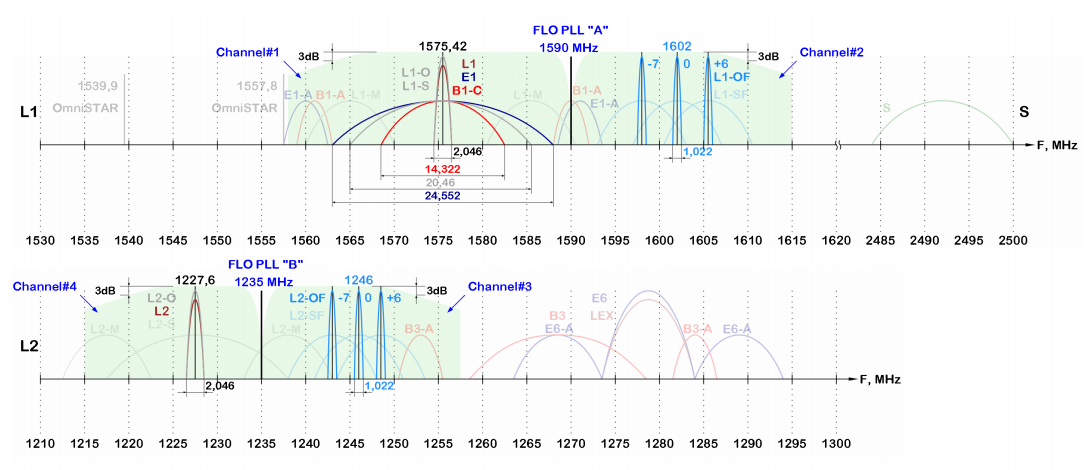
Variant frequency NT1065
After the introduction, examples of new tools for high-precision positioning, I'll tell you about the experience of designing a device to NT1065.
This part is about the different companies may seem boring. Beware, there are no pictures.
As usual in this adventure have got start-up companies. I don't know exactly who was the first of the two, will be called in the order in which noticed their announcements. The first — Swift Navigation, a company begins, but is already pretty potosina. She does RTK solutions ( RTK is a high — precision positioning system in real-time using base stations), began on Kickstarter with open-source single-frequency RTK device. Today they offer a Multi Piksi device that works in the ranges L1 and L2 and provides centimeter accuracy for only $ 595. For amounts less than $ 2,000 you can take two sets of RTK-antennas and communication system for the transmission of the amendments. I think it's very worried about the giants of the market.
The second company, Tersus GNSS. The Board receivers to view not different from the plat of Swift Navigation, is viewed the same FPGA Zync. Also have a set of antennas and a communication system. Here's more colorful descriptions of the new capabilities offered equipment for unmanned tractors and copters. They have the option of a receiver with two antennas for azimuth building high-precision receivers. These receivers accurately calculate the true heading of the vehicle, which is not always necessary, but to calculate it by other means very difficult.
Therefore, these two companies slowly eat a piece of cake giants of the industry, and those yet resting on their laurels. Both firms did not disclose the radio chip used in the technique and has made possible the rapid entry into the markets of the giants, but the dimensions of the devices can be understood that this is NT1065.
A few months later to the giants of the industry realized that if they did develop something revolutionary, then it's time to announce, otherwise it will just assume that they left in an unknown direction and stop to look at their website.
Trimble announced the product Catalyst. They immediately grasped the essence of the revolutionary process — opportunities to profit on the hardware will be less. So they made precision positioning service, service. It is necessary to buy for $ 350 piece of iron and to pay the monthly fee for the precision when it is needed. From meter accuracy for 40 bucks a month up to cm 350. However, their piece already contains an antenna and is connected directly to the device via USB. Supposedly a piece of iron just transfers the digitized signal, and a smartphone or tablet performs a software receiver (SDR — software defined receiver). It is unclear how they do it, great comp shuts up from the navigation SDR. They write about some special mobile devices on which to run their software. A connoisseur of the means of computation on the GPU said it can be OpenCL on mobile devices (I have not found much information, if someone knows, please share). But this is a real revolution! Though they are not the first, but the chances to get the championship they have with this thing much more than the first two.
At Trimble probably have your own solutions for radio receiving circuits, but it is possible that they were more profitable, too, to put NT1065. Though there is a to count the money, it turns out that to make a RPU on rassypuha will be cheaper. But laziness — the engine of progress. All stood still, until the chip is very simple to harness in the cart.
The second company, Tersus GNSS. The Board receivers to view not different from the plat of Swift Navigation, is viewed the same FPGA Zync. Also have a set of antennas and a communication system. Here's more colorful descriptions of the new capabilities offered equipment for unmanned tractors and copters. They have the option of a receiver with two antennas for azimuth building high-precision receivers. These receivers accurately calculate the true heading of the vehicle, which is not always necessary, but to calculate it by other means very difficult.
Therefore, these two companies slowly eat a piece of cake giants of the industry, and those yet resting on their laurels. Both firms did not disclose the radio chip used in the technique and has made possible the rapid entry into the markets of the giants, but the dimensions of the devices can be understood that this is NT1065.
A few months later to the giants of the industry realized that if they did develop something revolutionary, then it's time to announce, otherwise it will just assume that they left in an unknown direction and stop to look at their website.
Trimble announced the product Catalyst. They immediately grasped the essence of the revolutionary process — opportunities to profit on the hardware will be less. So they made precision positioning service, service. It is necessary to buy for $ 350 piece of iron and to pay the monthly fee for the precision when it is needed. From meter accuracy for 40 bucks a month up to cm 350. However, their piece already contains an antenna and is connected directly to the device via USB. Supposedly a piece of iron just transfers the digitized signal, and a smartphone or tablet performs a software receiver (SDR — software defined receiver). It is unclear how they do it, great comp shuts up from the navigation SDR. They write about some special mobile devices on which to run their software. A connoisseur of the means of computation on the GPU said it can be OpenCL on mobile devices (I have not found much information, if someone knows, please share). But this is a real revolution! Though they are not the first, but the chances to get the championship they have with this thing much more than the first two.
At Trimble probably have your own solutions for radio receiving circuits, but it is possible that they were more profitable, too, to put NT1065. Though there is a to count the money, it turns out that to make a RPU on rassypuha will be cheaper. But laziness — the engine of progress. All stood still, until the chip is very simple to harness in the cart.
Proceed to the production of the main weapon of the revolution. The main ingredients of two —
Consider what kind of beast NT1065? What horizons unearths the developer, with such a thing? How simple is it to learn?
Overall, it's a thing:
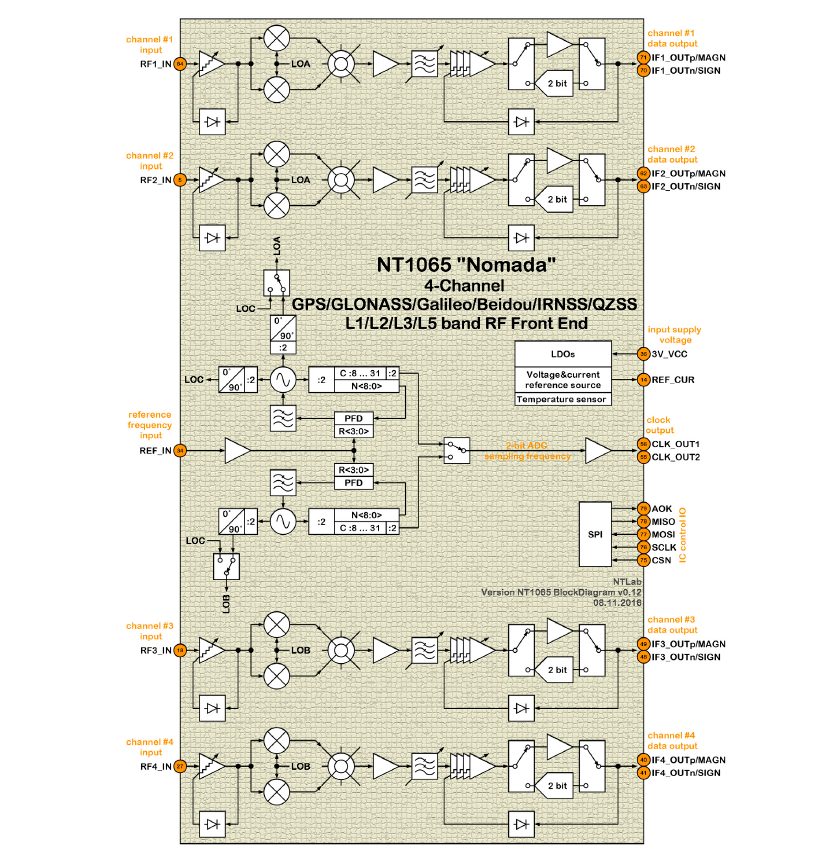
Four receive channels with separate inputs and two local oscillator, which can be flexibly record the mixer channels. Output signals can be in digital and in analog form. Thus, it is possible to implement the setting of each channel to your signal (with some restrictions), and simultaneous reception of the same signal on antenna diversity or antenna bars.
Now go through the details. At first glance, it is strange made the supply line is only one leg of the chip. But when wiring this thing turned into a pumpkin advantage. Although in some datasheets recommend these guys four layers, I easily fit in two! Any little bit nagastos gourmet chip that I couldn't do it.
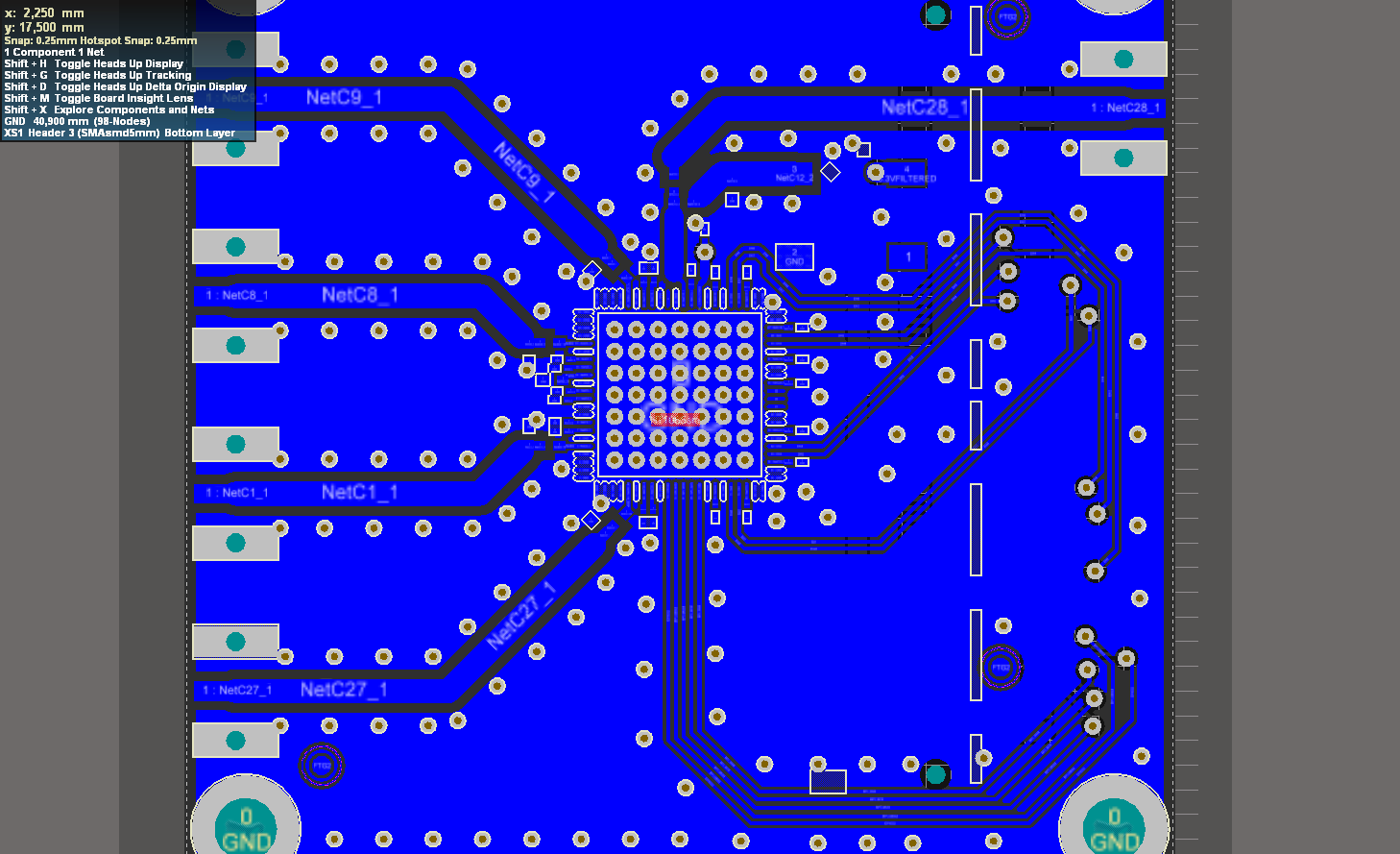
Further, in some datasheets they recommend to divide the lands of each channel for crosstalk was more. I almost killed myself and made such an option, but a significant increase in the interchange channels not seen. Whether measured wrong or did wrong. In General, the best the enemy of the good.
So, power from 2.8 to 3.3 Volts, the current is only 100 mA max. Really need to choose the power source with small noise. The DCDC is not suitable. The reference generator also needs a low noise, good frequency stability and temperature-compensated. The default settings of the supported face values of 10 MHz and 24.84 MHz. To use a different nominal frequency backups, it is necessary to contact developers.
Output interface is also very simple contacts and data. Of ADC bits in each channel only two, the sign and magnitude that brought me for a short time in a state of arrogance (I'm in my last job used to 16 digits), but that was enough. But the sampling rate is 100 MHz. Start the clock ticks to the clock input of the GPIFII interface controller CYUSB3014 and the data on the input data. We still have to get SPI to control and accurately, under the leadership dataset, to do the wiring and impedance matching at the input RPU and the revolver ready.

The Ntlab on the website there is a complete scheme of this card.
With the software even easier to receive the flow from Cypress FX3 on any OS is very simple: under Windows, and under Linux you can use libusb. Under Windows you can also use native driver from Cypress — no difference.
At the moment I have a set of soft (posted on GitHub, search for NT1065).
The main tool is a pair of programs. One of them is able to securely log on disk a continuous signal from the chip, and the second is suitable for the diagnosis and demonstrations.
It is possible to view the spectrum of the input signal (signal generator who have).
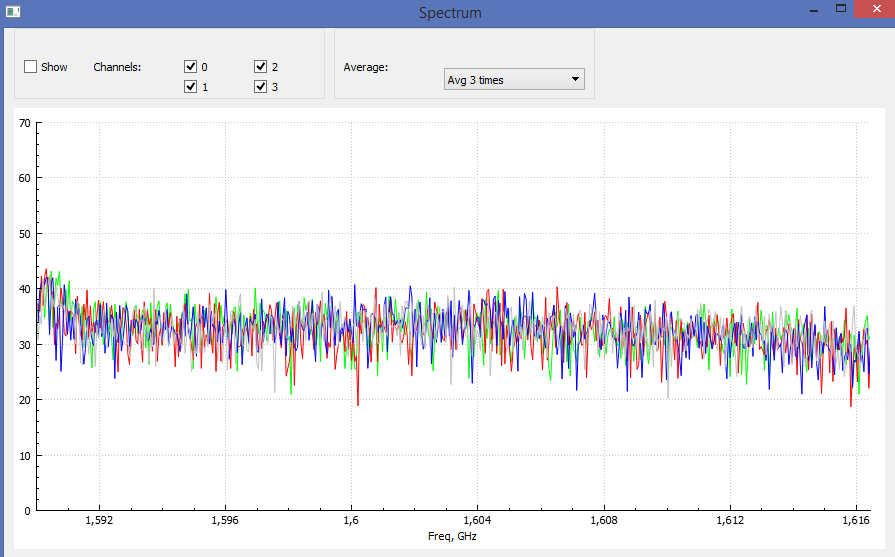
After connecting the antenna simple methods can be used to detect the satellite signals.
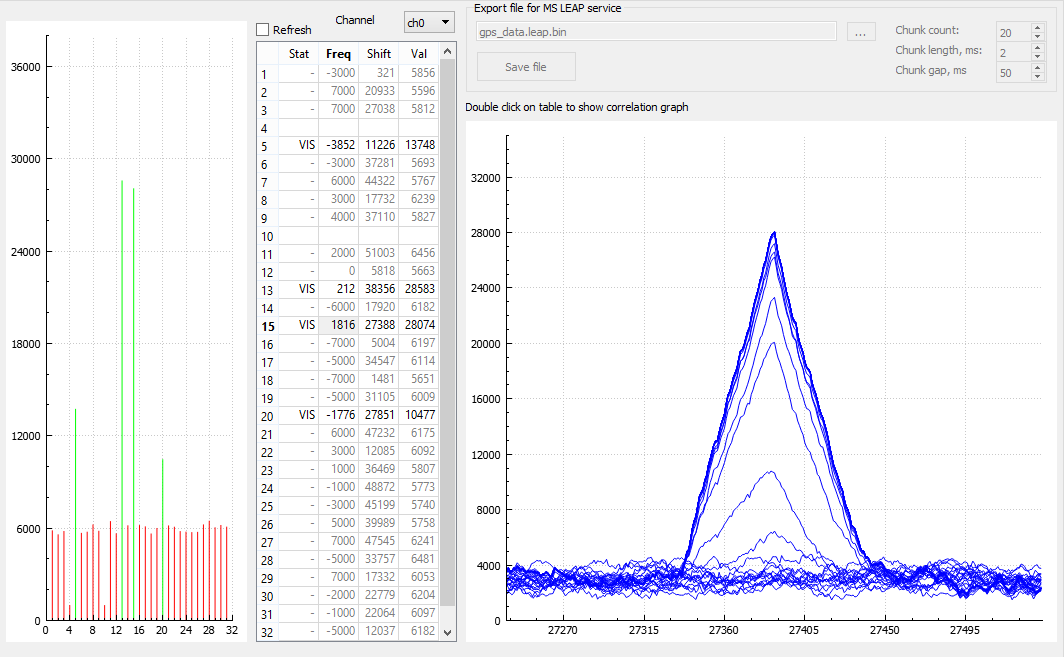
Not only GPS, and GLONASS frequency L1. And even GLONASS L2 frequency! Unlike the Americans, our transfer open source standard precision and L2 too.
To directly from the program you can choose GPS/GLONASS L1/L2, and to see the correlation — that I recently built, there Affairs on half an hour (now handles code rule for each case).
Now we are working on an Android version.
Now your options are to conquer the world, only limited by your ability to conceive and implement revolutionary device for satellite navigation!
PS
This article is a continuation of previous in the sense that here we consider the means that will be used for anti-interference and navigation receivers, as soon I hope to write on habré.
Which to me personally remains unclear: how is Trimble navigation's doing SDR on a mobile phone? At first I thought it was incredible, but then they sent me the sign, which shows the performance of modern computers mobile devices. So I want to ask people about the OpenCL-like technology for mobile devices. There's someone who used them? Theoretical performance in parrots I found, and where there is no mobile GPU tests in such tasks as, for example, FFT?
Sorry, the previous paragraph about Trimble and OpenCL can be confusing, because the text about Trimble above under the spoiler as possible boring. If anyone was wondering, read the above.
Well, the poster is quite aggressive and not exactly as specified in the header period in the history of Russia. What it for effect?
Comments
Post a Comment